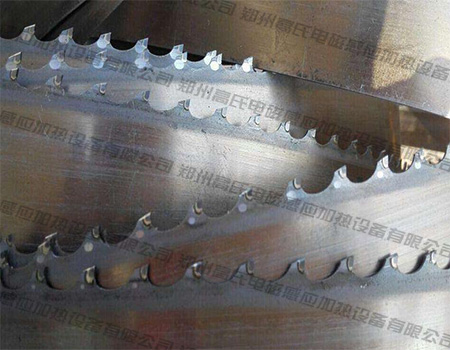For hand saw blades, its material is high carbon steel, and it is a very common method to quench and heat-treat it through a high-frequency induction heating machine. In the process of heat treatment, it is necessary to consider materials, manufacturing costs, equipment performance and Make reasonable choices in other aspects.
During the heat treatment process of sawtooth, there are steps such as preheating, heating, quenching and tempering. During preheating, the temperature should be around 600°C, which shortens the heating time, heats evenly, reduces the phenomenon of oxidation and decarburization, and avoids sawtooth The surface is deformed. When heating, in order to reduce the side bending of the saw blade, the saw blade will be heated when the clamp is in a tense state. If bending occurs, it should be straightened in time before cooling. Quenching is carried out after the heat preservation is over, but the heat preservation time should not exceed one minute. When tempering, the direction of the sawtooth should be the same, and two tempering can make the sawtooth obtain the required mechanical properties and strength.
Many saw blades are quenched by high-frequency induction heating machine. The parts to be quenched include the tooth saw and the back of the tooth. Higher, the toughness of the saw body is good, and it is not easy to break when it is bent, which reduces the breakage of the saw blade and reduces deformation. When sawing, due to the large frictional resistance, it can be nitrided once after heat treatment, which can not only improve the hardness of the middle part and the surface layer of the teeth, but also greatly improve its wear resistance and wear resistance. Fatigue performance and anti-seizure ability, etc.
During the whole process, it should be noted that since the serrated edge does not need to be ground, it is necessary to prevent oxidation and decarburization on its surface during heating and shorten the heating time as much as possible. If there is a defect of large deformation and low hardness of the saw blade, it will be found that the metallographic structure of the saw tooth has a serious and uniform decarburization layer. The depth of decarburization is different, and the stress on both sides after heat treatment is also different. After quenching, the saw tooth will tend to be decarburized. The thick side of the carbon layer is curved. This phenomenon can be avoided if heat treatment is carried out in time after carburizing.
From the service conditions and technical requirements of saw blades, in order to obtain ideal and qualified products, we must follow the formal processing steps, strictly follow the standard heat treatment process and operation requirements to produce, and correctly analyze and judge the heat treatment process. Problems that arise are resolved in a timely manner to improve production efficiency.




 en
en  cn
cn  jp
jp  ko
ko  de
de  es
es  it
it  ru
ru  pt
pt  vi
vi  th
th  pl
pl 







 GS-ZP-1200
GS-ZP-1200


